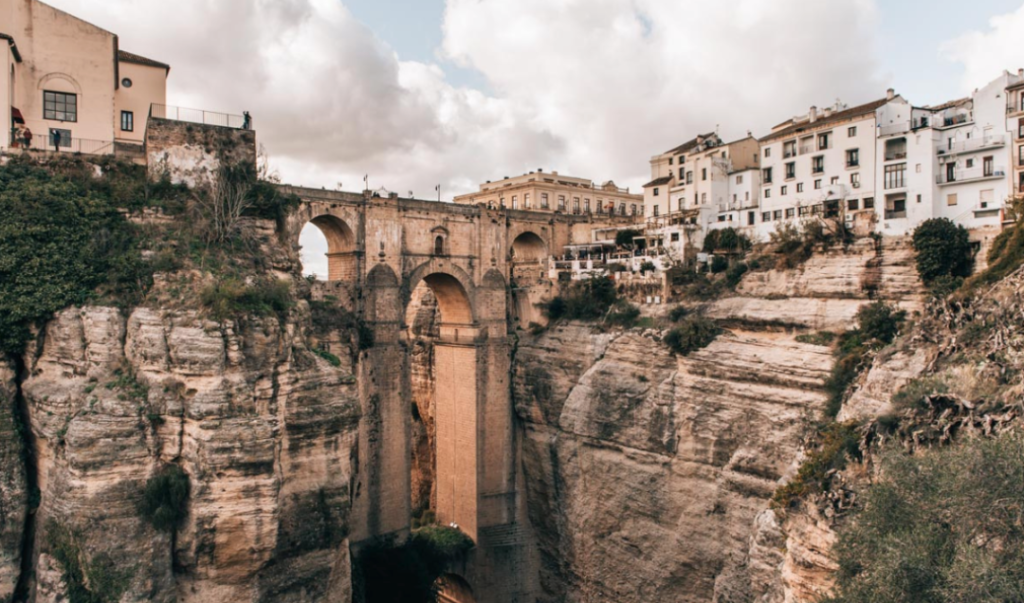A picture of ‘Puente Nuevo’ is sufficient to convince anyone for a trip down to Ronda. Once there, One can never stop boasting about Ronda. Although Ronda is well known for its “Pueblos Blancos” (White Towns) of Andalusia with a meagre population of 30,000 people, the ‘to be explored on-foot’ Moorish Old Town (La Ciudad) area retains its old charm. Especially early morning or Late night when majority of crowd has escaped. The sheer cliffs of El Tajo leading down to Rio Guadalevin are fascinating from every angle.
To sum up, Ronda is a a globally know spot for various reasons, be it as simple as being an iconic photoshoot location to being the favourite town of Ernest Hemingway and everything in between is what makes Ronda, Ronda.
Here we have listed down a few must-do things when in Ronda.
- Puente Nuevo
- Ernest Hemingway
- Alameda del Tajo
- Bandit Museum
- Church of Santa Maria la Mayor
Puente Nuevo
The Puente Nuevo, which like something out of Game of Thrones, connects two sides of Ronda’s ancient city across a tiny abyss. Despite how amazing it is, it was erected in a tragic environment because the prior building collapsed, killing 50 people.
A room with an exhibition on the history of the bridge is now housed in the chamber above the central arch, where there is no chance of being tortured.
Connects: El Mercadillo and La Ciudad
Ticket Price: €2
Ernest Hemingway
Ernest Hemingway, one of the most well-known American writers of all time, is best known for timeless works like For Whom the Bell Tolls and The Old Man and the Sea. As a Spanish Civil War correspondent, Hemingway first travelled to Ronda in 1937 and fell head over heels for the city and bullfighting.
In several of his writings, notably The Sun Also Rises, A Dangerous Summer, and Death in the Afternoon, he wrote about the war, bullfighting, and the city of Ronda. For Whom the Bell Tolls also contains a scene that depicts fascist sympathisers being hurled from a cliff to their deaths. This scene is allegedly based on genuine events that occurred at Ronda’s Plaza de Espaa in 1936.
Officially known as Paseo Blas Infante, the route that runs alongside the gorge from the Plaza de Toros to the Plaza de Espaa is also known as Paseo de Hemingway since the author spent a lot of time there strolling.
Address: P.º Blas Infante, 1, 29400 Ronda, Málaga, Spain
A 2-min walk from the Puente Nuevo.
Timings: Open 24*7.
Alameda del Tajo
The avenue and park, which were constructed in the 19th century, are flanked by historic trees and monuments and enjoy beautiful vistas of distant mountains at one end. a lovely location for sunsets.
The Alameda del Tajo, which is situated close to the cliffs of Ronda Canyon El Tajo, was formerly known as Alameda de San Carlos. The Monumento a la Dama Goyesca (Monument of the Goyaesque Lady), a life-size statue of a woman wearing the local attire of Ronda, is situated inside the park.
This charming park in Ronda is a wonderful location to calm down and take in free musical performances, artists, or just sit and people-watch in the midst of the historical landmarks, natural marvels, restaurants, cafes, and the bullring. There are more gorge vistas, but the park’s vegetation and lounging areas let visitors unwind and observe others. Additionally, there is a gazebo where musicians play during the day. I also enjoyed perusing the artisans’ and artists’ creations.
Address: P.º Blas Infante, 1, 29400 Ronda, Málaga, Spain
Timings: 8am – 10 pm
Bandit Museum
For a little change of pace, you may want to check out the Bandit Museum, filled with thorough profiles of notorious bandits. It is a little bit odd how much these murderous criminals are romanticized, though, which is probably due to their connection with anti-fascist rebels during the Spanish Civil War. Nonetheless, despite their apparent admiration for the lawless lifestyle of the banditos, they still firmly believe in enforcing today’s rules.
Address: C. Armiñán, 65, 29400 Ronda, Málaga, Spain
Timings: 11am – 7:30pm
Ticket Price: €4
Church of Santa Maria La Mayor
Classified as National Monument of Spain, once a mosque now converted into a church, this building is a exciting mix of style and architecture. There is an arch covered in Arabic inscriptions and an unusual central choir stall that divides the entire church in two. It is also famous, and rather obvious, due to its impressive bell tower. One should definitely climb up the bell tower for a never seen before view. One can witness whole city altogether from the top.
Address: P.za di Santa Maria Maggiore, 00100 Roma RM, Italy
Architectural styles: Romanesque architecture, Baroque architecture, Ancient Roman architecture, Medieval architecture

